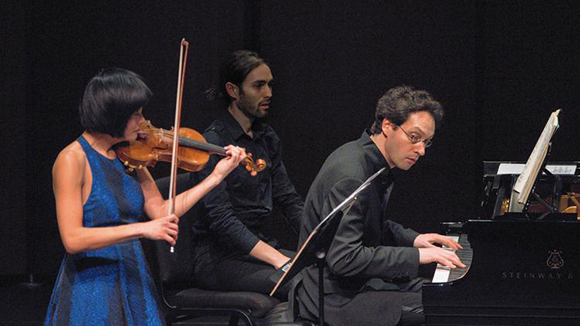Los Angeles Times
By Mark Swed
March 28, 2016
original
link
L.A. Phil covers lusty Modern Italian with gusto

Jennifer Koh and Shai Wosner perform in "Bridge to Beethoven" on March 26, 2016, at the Wallis Annenberg Center for the Performing Arts in Beverly Hills. (Rob Latour / The Wallis Annenberg Center for the)
A prodigious builder of musical bridges, Jennifer Koh is a violinist with a number of ongoing projects meant to connect people, disciplines and eras. To gain insight into a musician's mind, for instance, she recently allowed doctors at Duke University to scan her brain while she played Paganini. To help pay for her violin, she has found assistance from a who's who of 24 mostly American composers pleased to write short caprices for her. Director Robert Wilson, stunned by her playing and presence in his latest revival of "Einstein on the Beach," has begun formulating a theater piece with her about the life of Bach.
"Bridge to Beethoven" is yet another Koh conduit. Her cycle of the 10 Beethoven violin sonatas with pianist Shai Wosner incorporates a new work written for each of the four programs. The third, devoted to Beethoven's three Opus 30 sonatas, was given for the first time at the Wallis Annenberg Center for the Performing Arts on Saturday night (it will be repeated April 5 as part of UC Santa Barbara's Arts & Lectures series).
The contemporary composer this time was Andrew Norman, and rather than write a companion piece — as Jörg Widmann had for the "Spring" Sonata, Vijay Iyer for the "Kreutzer" Sonata and Anthony Cheung for the Tenth — Norman came up with "Bridging I-III." The three short transitional movements start where one Beethoven sonata ends and transform that cadence into something that leads to the opening music of the next sonata.
It's an apt idea. Beethoven was a master of musical morphing, obsessing on a detail of melodic or harmonic or rhythmic motive and transmogrifying its soul into something unexpected. What makes this radical, though, was that Beethoven's genius was less for bridging than tunneling. He had no intention of letting you see what looms on the other side. Instead, he takes you mysteriously inside the music, leaving you to abruptly emerge into new realms.
Norman's "Bridging" turns out to be just such radical tunneling. Rather than offer companionship to Beethoven's sonatas, he changes the context of their surroundings. A familiar sonata does not start the way it normally does out of anticipatory silence, but it comes upon its audience unexpectedly.
Koh's program put the first and third sonatas together on the first half of the program, common-sensically withholding the most impressive and dramatic and longest — the C-Minor Sonata, Opus 30, No. 2 — until after intermission. But the sense is no longer common when the evening begins with percussive chords based on the last measures of the E-Minor sonata to be heard at evening's end. "Bridging I" leads directly into the A-Major piano chord and flourish of the first two measures of Opus 30, No. 1. "Bridging II" likewise connects this sonata with Opus 30, No. 3. There is no break for 50 minutes.
"Bridging III," beginning after intermission, is the longest (at around five minutes) of the three movements. Here Norman enters into a kind of mystical stasis of slow-moving harmonies that feels somewhere between Beethoven in his most visionary mode and the slow music of Morton Feldman. That Norman, who came to attention with the manic music of a USC undergraduate, can now magnificently stop time as a 35-year-old (who has returned to USC as a star of its music faculty) may have influenced Koh's unusually serene take on these Beethoven sonatas.
The scores came at the end of Beethoven's early period. He followed the old tradition of labeling them as piano sonatas with violin accompaniment, but as important as the piano part is, we now hear the instruments as unequal, the violin dominating. They are transitional works, based on Classical style graciousness but undercut by hints of the dramatic, wild and visionary sides of Beethoven to come. The fashion among violinists has long been not to hint at anything but to chase down all future promises of Beethovenian zeal.
Koh, instead, maintained an exceptional even keel, her tone pure, not muddied by excessive vibrato. She phrased with elegance. Wosner proved an equally understated and elegant partner. Slow movements were exquisite.
But when brusque percussive attacks by the violin or a groundswell run of a sudden rapid scale passage under an otherwise placid violin surface were called for, Koh and Wosner generated an intensity that seemed to come out of nowhere. Beauty was fractured, which might be how Beethoven's audiences, shocked and thrilled, experienced it.
We cannot deny history, but we can't relive it either. To restore a sense of innovation requires new innovation. The logical conclusion to this bridge to Beethoven would be to play all three sonatas together nonstop for 80 minutes.
Better still might be to really begin in medias res, say, in a middle movement of a sonata. The exact starting point could be chosen by chance for each performance, making every night a new adventure. But even as it was Saturday, the bridge, or tunnel, constructed by Koh, Wosner and Norman was able to brilliantly alter perceptions, which is what makes Beethoven essential.
Copyright ©2016 Los Angeles Times
© Jennifer Koh, All Rights Reserved. Photography by Juergen Frank. Site by ycArt design studio